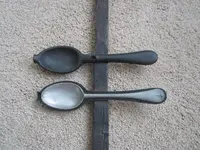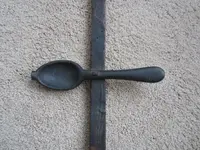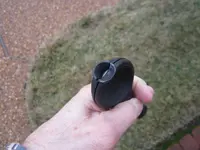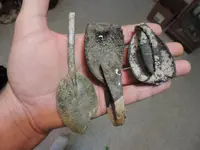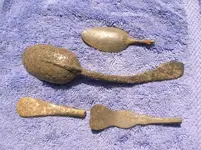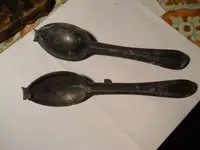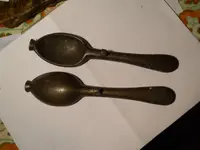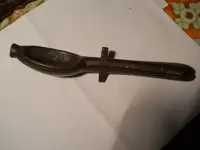Bill D. (VA)
Silver Member
- Joined
- Oct 7, 2008
- Messages
- 4,711
- Reaction score
- 6,212
- Golden Thread
- 6
- Location
- SE Virginia
- 🥇 Banner finds
- 6
- 🏆 Honorable Mentions:
- 2
- Detector(s) used
- F75 SE (land); CZ-21 (saltwater)
- Primary Interest:
- Other
While we're talking about colonial spoons here's a cool item I recently acquired
This is an 18th century Hanoverian rat tail spoon mold. It was found in the cellar of an early tavern and comes mounted on a stick of wood that's very aged and has a string attached to one end for hanging on the wall. Additionally, a rat tail pewter spoon that was actually cast from this same mold was included. This can be verified by comparing the subtle details of the mold with the spoon, and everything matches perfectly. This pattern of flatware was in prevalent use in the colonies from 1715 through the 1770s. Since the spoon contains no makers marks it's assumed it was used locally by the tavern to produce its own flatware as opposed to importing it. The melted pewter was simply poured into the opening at the top of the mold and allowed to cool. This mold also seems to cast a heavier than average spoon with a heavy, rounded stem. The intent may have been to cast durable serving spoons for the tavern as most common spoons have thinner, flat stems. This isn't nearly as old as the mid-1600s trifid spoon I found on Tues, but it will make a nice display piece to show alongside my other rat tail spoons.
This is an 18th century Hanoverian rat tail spoon mold. It was found in the cellar of an early tavern and comes mounted on a stick of wood that's very aged and has a string attached to one end for hanging on the wall. Additionally, a rat tail pewter spoon that was actually cast from this same mold was included. This can be verified by comparing the subtle details of the mold with the spoon, and everything matches perfectly. This pattern of flatware was in prevalent use in the colonies from 1715 through the 1770s. Since the spoon contains no makers marks it's assumed it was used locally by the tavern to produce its own flatware as opposed to importing it. The melted pewter was simply poured into the opening at the top of the mold and allowed to cool. This mold also seems to cast a heavier than average spoon with a heavy, rounded stem. The intent may have been to cast durable serving spoons for the tavern as most common spoons have thinner, flat stems. This isn't nearly as old as the mid-1600s trifid spoon I found on Tues, but it will make a nice display piece to show alongside my other rat tail spoons.
Attachments
Last edited:
Upvote
21




